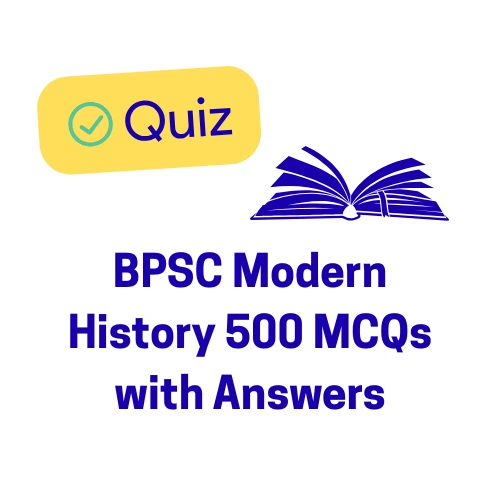BPSC Modern History Part 3 (500 MCQs), focus on the Consolidation of British Power in India, including Punjab, Awadh, and the British Administrative Structure (Regulating Act, Pitt’s India Act).
BPSC Modern History Part 3 (500 MCQs)
Section E: Consolidation of Power (Sikhs & Punjab)
Q61. Who was the founder of the Sikh Kingdom in the Punjab, uniting the 12 Sikh Misls (confederacies)?
(A) Guru Gobind Singh
(B) Ranjit Singh
(C) Guru Nanak Dev
(D) Banda Bahadur
Q62. From which Misl (confederacy) did Maharaja Ranjit Singh belong?
(A) Phulkian Misl
(B) Ahluwalia Misl
(C) Sukerchakia Misl
(D) Bhangi Misl
Q63. The Treaty of Amritsar (1809) was signed between Maharaja Ranjit Singh and the British East India Company. Who was the British representative in the signing of this treaty?
(A) Lord Wellesley
(B) Lord Hastings
(C) Charles Metcalfe
(D) Sir Henry Lawrence
Q64. What was the main provision of the Treaty of Amritsar (1809)?
(A) The British accepted Ranjit Singh as the ruler of the entire Punjab.
(B) Ranjit Singh was allowed to expand his territory east of the Sutlej River.
(C) The Sutlej River was fixed as the boundary between Ranjit Singh’s territories and the British territories.
(D) The British agreed to withdraw their forces from the Cis-Sutlej states.
Q65. The First Anglo-Sikh War (1845-1846) was concluded by which treaty?
(A) Treaty of Lahore
(B) Treaty of Amritsar
(C) Treaty of Bhyrowal
(D) Treaty of Rawalpindi
BPSC Modern History Part 3 (500 MCQs)
Q66. Who was the last Maharaja of the Sikh Empire, who was a minor during the Anglo-Sikh Wars and later converted to Christianity?
(A) Kharak Singh
(B) Nau Nihal Singh
(C) Dalip Singh
(D) Sher Singh
Q67. The Second Anglo-Sikh War (1848-1849) resulted in the final annexation of Punjab. This annexation took place during the tenure of which Governor-General?
(A) Lord Ellenborough
(B) Lord Hardinge I
(C) Lord Dalhousie
(D) Lord Canning
Q68. The famous Battle of Chillianwala, a major engagement of the Second Anglo-Sikh War, was fought in which year?
(A) 1845
(B) 1846
(C) 1848
(D) 1849
Q69. After the annexation of Punjab, a three-member Board of Administration was constituted. Who among the following was the President of this Board?
(A) John Lawrence
(B) Henry Lawrence
(C) Charles Napier
(D) James Outram
Q70. The Anglo-Sikh Wars and the subsequent annexation of Punjab marked the completion of the British Empire’s expansion into which direction of India?
(A) East
(B) West
(C) North-West
(D) South-East
Section F: Consolidation of Power (Awadh & Others)
Q71. Who was the founder of the independent dynasty/state of Awadh (Oudh)?
(A) Burhan-ul-Mulk Saadat Khan
(B) Safdar Jung
(C) Asaf-ud-Daula
(D) Shuja-ud-Daula
Q72. Which Nawab of Awadh permanently shifted the capital from Faizabad to Lucknow?
(A) Saadat Khan
(B) Safdar Jung
(C) Asaf-ud-Daula
(D) Wajid Ali Shah
Q73. Awadh was annexed to the British Empire in 1856 on the ground of:
(A) Failure to pay war indemnity
(B) Doctrine of Lapse
(C) Alleged misgovernance and maladministration
(D) Refusal to sign the Subsidiary Alliance
Q74. Who was the last Nawab of Awadh, who was deposed and exiled to Calcutta upon the state’s annexation?
(A) Shuja-ud-Daula
(B) Asaf-ud-Daula
(C) Wajid Ali Shah
(D) Begum Hazrat Mahal
Q75. The annexation of Awadh took place during the Governor-Generalship of:
(A) Lord Wellesley
(B) Lord Auckland
(C) Lord Dalhousie
(D) Lord Canning
BPSC Modern History Part 3 (500 MCQs)
Q76. Which of the following principalities was annexed by the British using the Doctrine of Lapse policy:
(1) Satara
(2) Jhansi
(3) Nagpur
(4) Awadh
(A) 1, 2, and 3 only
(B) 1, 3, and 4 only
(C) 2, 3, and 4 only
(D) 1, 2, 3, and 4
Q77. The first state to be annexed under the Doctrine of Lapse (1848) was:
(A) Sambalpur
(B) Satara
(C) Jhansi
(D) Nagpur
Q78. The Second Burmese War (1852) resulted in the annexation of which part of Burma by the British?
(A) Upper Burma
(B) Lower Burma (Pegu)
(C) Arakan
(D) Tenasserim
Q79. Which city was known as the ‘Key to the British Empire’ in India due to its strategic location on the North-West frontier, which led to the First Anglo-Afghan War (1839-1842)?
(A) Kabul
(B) Kandahar
(C) Quetta
(D) Peshawar
Q80. The region of Sindh was conquered and annexed by the British in which year?
(A) 1839
(B) 1843
(C) 1845
(D) 1849
Section G: Constitutional Development (1773-1853)
Q81. Which act created the post of Governor-General of Bengal, and who was the first person to hold this office?
(A) Pitt’s India Act, 1784; Lord Cornwallis
(B) Regulating Act, 1773; Warren Hastings
(C) Charter Act, 1833; Lord William Bentinck
(D) Charter Act, 1853; Lord Dalhousie
Q82. The Regulating Act of 1773 established the Supreme Court in Calcutta. The first Chief Justice of this court was:
(A) Sir Elijah Impey
(B) Sir Hyde East
(C) Lord Macaulay
(D) Sir Charles Wood
Q83. Which act distinguished between the commercial and political functions of the East India Company for the first time by establishing the Board of Control?
(A) Regulating Act, 1773
(B) Pitt’s India Act, 1784
(C) Charter Act, 1813
(D) Charter Act, 1833
Q84. Under the Pitt’s India Act of 1784, the Board of Control was established in England. This body was responsible for:
(A) Regulating the trade of the Company in India.
(B) Managing the political, civil, and military government or revenues of the Company’s territories.
(C) Supervising the commercial affairs of the Company.
(D) Appointing the Governor-General of India.
Q85. Which Charter Act is considered the beginning of the concept of a written constitution (though not a formal one) in India?
(A) Regulating Act, 1773
(B) Charter Act, 1813
(C) Charter Act, 1833
(D) Charter Act, 1853
BPSC Modern History Part 3 (500 MCQs)
Q86. Which Charter Act abolished the Company’s trade monopoly in India, allowing British subjects to trade with India, except in tea and trade with China?
(A) Charter Act of 1793
(B) Charter Act of 1813
(C) Charter Act of 1833
(D) Charter Act of 1853
Q87. Which Charter Act designated the Governor-General of Bengal as the Governor-General of India and centralized the legislative powers?
(A) Charter Act of 1813
(B) Charter Act of 1833
(C) Charter Act of 1853
(D) Pitt’s India Act, 1784
Q88. Which of the following provisions was/were introduced by the Charter Act of 1833?
(1) Attempted to introduce a system of open competition for the selection of civil servants
(2) Ended the activities of the East India Company as a commercial body.
(3) Created a separate Governor for the Presidency of Bengal.
(A) 1 only
(B) 2 only
(C) 1 and 2 only
(D) 1, 2, and 3
Q89. Which Charter Act provided for the first time for the separation of the legislative and executive functions of the Governor-General’s Council?
(A) Charter Act of 1793
(B) Charter Act of 1813
(C) Charter Act of 1833
(D) Charter Act of 1853\
Q90. Which legal member was added to the Governor-General’s Council by the Charter Act of 1833 and subsequently became the first Law Member?
(A) Thomas Munro
(B) Lord Macaulay
(C) Charles Wood
(D) Lord Hardinge

